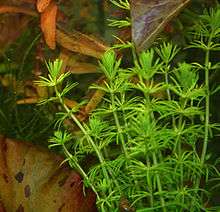Bacopa
| Bacopa | |
|---|---|
 | |
| Bacopa monnieri | |
| Scientific classification | |
| Kingdom: | Plantae |
| Clade: | Angiosperms |
| Clade: | Eudicots |
| Clade: | Asterids |
| Order: | Lamiales |
| Family: | Plantaginaceae |
| Tribe: | Gratioleae |
| Genus: | Bacopa Aubl.[1] |
| Species | |
|
See text | |
| Synonyms | |
|
Brami Adans. | |
Bacopa is a genus of 70–100 aquatic plants belonging to the family Plantaginaceae. It is commonly known as waterhyssop (or water hyssop, though this is more misleading as Bacopa is not very closely related to hyssop but simply has a somewhat similar appearance).
Description
They are annual or perennial, with decumbent or erect stems. The leaves are opposite or whorled, and sessile. The leaf blade is regular, round to linear, and the venation is palmate or pinnate. Its stems are hairy or smooth. The flowers are produced solitary or in pairs from leaf axils, usually radially symmetrical, with five sepals and five petals, and they are usually white, blue, or purple. Dispersal and propagation is by seeds and stem fragments. Crushed leaves have a distinctive 'lemon' scent.

Habitat and range
Bacopa species are found in tropical and subtropical regions of the world, particularly the Americas. A few are regarded as weeds and excess stock should not be dumped in warmer regions. Most grow in moist amphibious conditions, though some like B. myriophylloides seem to be wholly aquatic.
Uses
Bacopa monnieri, syn. Herpestis monniera, is important in Ayurvedic medicine and has been used, particularly in India, for several thousand years in the belief that it helps mental functioning, including comprehension (Dhi), memory (Dhriti), and recollection (Smriti).[2]
Cultivation
Some of these species are commonly used in freshwater aquariums and around and in ponds in warmer climates. Most are easy to grow and are slow-growing, but require medium to high amounts of light. Most are easy to grow and will tolerate a wide range of water conditions. B. caroliniana at least will tolerate brackish water. Plants are usually best planted in groups in the middle to background. Algal infestation can be a problem in brighter lighting condition.[3]
Selected species
|
|
Formerly placed here
- Mecardonia procumbens (Mill.) Small (as B. procumbens (Mill.) Greenm.)[4]
See also
- Chaenostoma cordatum syn. Sutera cordata, a plant also known by the obsolete name Bacopa.
References
| Wikimedia Commons has media related to Bacopa. |
| Wikispecies has information related to Bacopa |
- ↑ "Genus: Bacopa Aubl". Germplasm Resources Information Network. United States Department of Agriculture. 2007-10-05. Retrieved 2011-01-18.
- ↑ "Bacopa Moniera". Archived from the original on 26 April 2012. Retrieved 7 December 2012.
- ↑ Native Plants Hawaii. "Bacopa monnieri". Retrieved 19 July 2012.
- 1 2 3 "GRIN Species Records of Bacopa". Germplasm Resources Information Network. United States Department of Agriculture. Retrieved 2011-01-18.
- 1 2 "Bacopa". Integrated Taxonomic Information System. Retrieved 2011-01-18.
